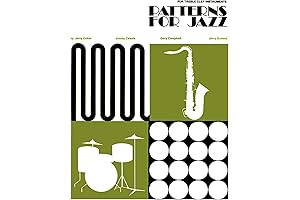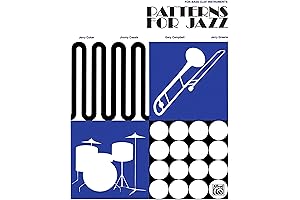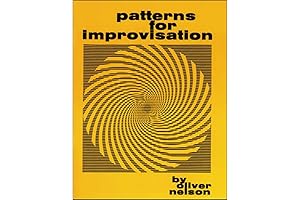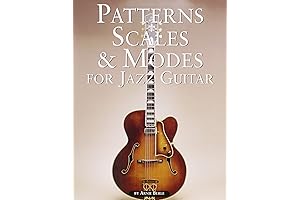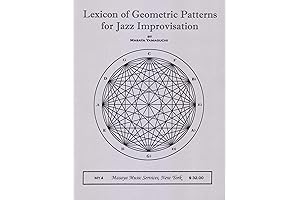· jazz patterns · 13 min read
The Ultimate Guide to Patterns for Jazz
Discover the essential patterns for jazz improvisation and composition. Unleash your creativity and elevate your jazz skills with our comprehensive guide.
Embark on a musical journey with our in-depth exploration of patterns for jazz. Whether you're a seasoned musician or a budding enthusiast, this guide will provide you with the essential knowledge and techniques to enhance your jazz improvisation and composition skills. Dive into the world of jazz patterns and unlock your musical potential!
Overview

PROS
- Offers a comprehensive overview of jazz theory, guiding aspiring musicians through the intricacies of this genre.
- Features clear explanations and a wealth of musical examples, making it accessible to players of all levels.
CONS
- Primarily focused on treble clef instruments, limiting its scope for musicians playing bass or other non-treble instruments.
- Some readers may find the level of detail overwhelming, especially if they're new to jazz theory.
Patterns for Jazzis the perfect tool for musicians looking to enhance their jazz composition and improvisation skills. Engaging and informative, it provides a deep dive into jazz theory, covering essential aspects like scales, chords, voicings, and harmonic progressions, all tailored specifically for treble clef instruments.
With its clear and accessible approach, Patterns for Jazz simplifies complex concepts, making them easy to grasp. The abundance of musical examples and exercises further solidifies understanding, offering practical ways to apply the theory to real-world playing. Whether you're a seasoned pro or just starting your jazz journey, Patterns for Jazz is an invaluable resource that will elevate your musicality to new heights.

PROS
- Provides a comprehensive guide to jazz theory and composition for bass clef instruments
- Features a rich collection of essential jazz patterns and techniques for improvisation
- Includes clear and concise explanations with detailed examples and ejercicios
CONS
- May require prior musical knowledge to fully grasp the concepts
- Some readers may find the theoretical aspects dense at times
Embark on a transformative journey into the world of jazz theory and improvisation with 'Patterns for Jazz'! This remarkable text, tailored specifically for bass clef instruments, serves as an invaluable resource for musicians seeking to master the intricacies of this captivating genre. Immerse yourself in a comprehensive exploration of jazz theory, gaining insights into scales, chords, progressions, and voicings.
Unleash your creativity with a vast repertoire of essential jazz patterns. From bebop lines to walking bass grooves and modal explorations, this guide empowers you to navigate the improvisational landscape with confidence. Each pattern is meticulously explained and accompanied by practical examples, ensuring a deep understanding of its application. Whether you're a seasoned pro or aspiring jazz enthusiast, 'Patterns for Jazz' provides the essential tools and knowledge to elevate your musicality.

PROS
- Provides a structured approach to learning jazz improvisation through patterns.
- Covers a wide range of jazz styles, including bebop, swing, and modal.
- Includes exercises and practice routines to help you integrate patterns into your playing.
- Guided by experienced jazz educators, providing valuable insights and guidance.
CONS
- Requires a foundational understanding of jazz theory and improvisation.
- The sheer volume of patterns can be overwhelming for beginners.
Patterns for Jazz is an indispensable resource for aspiring jazz musicians seeking to master the art of improvisation. This comprehensive guide presents a systematic approach, breaking down jazz improvisation into manageable patterns. Covering an array of jazz styles, from bebop to modal, this book provides aspiring jazz musicians with a structured path to developing their improvisational skills.
Authored by renowned jazz educators, Patterns for Jazz goes beyond mere theory, offering invaluable exercises and practice routines to help you effortlessly integrate patterns into your playing. Its engaging and insightful approach makes learning jazz improvisation not only accessible but also enjoyable. However, it's important to note that a fundamental understanding of jazz theory and improvisation is essential for optimal utilization of this guide. Additionally, the sheer number of patterns presented may be daunting for absolute beginners, requiring a dedicated effort to fully grasp the content.

PROS
- Provides a comprehensive guide to rhythmic patterns in jazz improvisation.
- Includes exercises and practice tips to enhance your improvisational skills.
CONS
- May not be suitable for absolute beginners in jazz improvisation.
- Focuses primarily on rhythmic patterns, neglecting other aspects of improvisation.
Unleash your improvisational prowess with Patterns for Improvisation, an in-depth guidebook that empowers you to navigate the rhythmic intricacies of jazz. This invaluable resource seamlessly blends theory and practical exercises, propelling your jazz mastery to new heights.
With Patterns for Improvisation, you'll embark on a rhythmic journey through the heart of jazz improvisation. Each pattern is meticulously dissected, revealing its nuanced intricacies. Through engaging exercises and expert guidance, you'll internalize these patterns, unlocking a boundless vocabulary for spontaneous and captivating solos. Whether you're a seasoned improviser or just starting your jazz adventure, this book is an indispensable tool, providing a solid foundation and igniting your creative spark.

PROS
- An extensive compilation of scales commonly employed in jazz improvisation.
- A wealth of melodic patterns empowers musicians to craft captivating solos.
CONS
- Lacks incorporation of rhythm and harmony in musical examples.
- May not cater to all skill levels
For the jazz musician seeking to expand their improvisational and melodic toolkit, the 'Spiral-Bound Repository of Scales and Melodic Patterns' stands as an indispensable companion. Within its pages, a comprehensive collection of scales awaits, each meticulously organized for ease of reference during practice or performance.
Beyond scales, this repository unveils a treasure trove of melodic patterns, providing a rich source of inspiration for soloing. Aspiring jazz improvisers will find themselves immersed in a world of musical possibilities, drawing inspiration from these patterns to craft captivating and expressive solos. However, it is worth noting that the resource does not delve into the intricacies of rhythm and harmony, focusing primarily on melodic elements. Additionally, some may find the book's approach less suitable for beginners, as prior knowledge of music theory can enhance its utility.

PROS
- Comprehensive and systematic approach to jazz improvisation
- Provides essential patterns and exercises for all levels of jazz musicians
- Improves technique, rhythmic accuracy, and harmonic understanding
CONS
- May require additional guidance for beginners
- Can be challenging for advanced players
Master the art of jazz improvisation with 'Essential Patterns for Jazz Mastery', a meticulously crafted resource designed to elevate your musical prowess. This comprehensive guidebook provides a structured approach, guiding you through the intricacies of jazz patterns, scales, and rhythms, empowering you to unlock your creative potential.
Structured meticulously, this volume unveils essential patterns and exercises tailored to musicians of all levels, from budding enthusiasts to seasoned professionals seeking to refine their technique. Through progressive lessons, you'll delve into the fundamentals of jazz improvisation, solidifying your rhythmic accuracy, harmonic understanding, and improvisational skills. Immerse yourself in the ever-evolving world of jazz and elevate your musical journey with 'Essential Patterns for Jazz Mastery', an invaluable companion for any dedicated jazz musician eager to reach the pinnacle of their craft.

PROS
- Master the art of pentatonic scales for captivating jazz solos
- Improvise confidently with expanded harmonic possibilities
CONS
- May require some prior music theory knowledge
- Focus solely on pentatonic scales, excluding other jazz-specific scales
Embark on a musical journey with 'Pentatonic Scales for Jazz Improvisation,' a comprehensive guide that unlocks the power of pentatonic scales for jazz enthusiasts. This book, tailored for aspiring jazz musicians, serves as a practical roadmap for mastering these essential scales and incorporating them seamlessly into your improvisational vocabulary. Through a blend of clear explanations and practical exercises, the book empowers you to explore the melodic and harmonic possibilities that pentatonic scales offer.
The author, Ramon Ricker, brings a wealth of experience and expertise to this invaluable resource. With a systematic approach and a deep understanding of jazz theory, Ricker presents the nuances of pentatonic scales, providing valuable insights and techniques for effective improvisation. Delve into the intricacies of pentatonic scales, uncover their applications in different jazz contexts, and elevate your solos with newfound creativity. Whether you're a seasoned jazz improviser or embarking on your musical adventure, this book will ignite your passion for improvisation and propel you to new heights of jazz expression.

PROS
- Comprehensive guidebook for enhancing jazz guitar skills
- In-depth coverage of scales, modes, and patterns essential for improvisation and soloing
CONS
- May be overwhelming for beginners
- Requires a good foundation in music theory
For aspiring jazz guitarists seeking to elevate their playing, Patterns, Scales & Modes for Jazz Guitar presents an indispensable guide. This comprehensive handbook meticulously unravels the intricacies of jazz guitar by delving into scales, modes, and patterns foundational to improvisation and soloing. With its systematic approach and wealth of exercises, this volume empowers guitarists to unlock the secrets of jazz guitar mastery.
Patterns, Scales & Modes for Jazz Guitar stands out for its thorough exploration of jazz theory, equipping readers with a profound understanding of the building blocks of jazz improvisation. Through clear explanations, detailed diagrams, and abundant musical examples, the book fosters a deep comprehension of scales, modes, and patterns, enabling guitarists to navigate complex jazz harmonies with confidence and creativity.

PROS
- Provides a comprehensive collection of jazz saxophone licks, phrases, and patterns for all skill levels.
- Features clear demonstrations and expert insights to help you master each pattern effectively.
- Enhances your jazz improvisation skills, enabling you to create captivating solos and embellishments.
CONS
- May require a basic understanding of jazz theory to fully grasp some of the patterns.
- The accompanying audio examples could be improved for better clarity.
If you're eager to elevate your jazz saxophone playing, look no further than this exceptional guide. With its meticulously curated selection of licks, phrases, and patterns, you'll discover a treasure trove of inspiration to enhance your improvisations and unlock your musical creativity. The expert demonstrations and insightful commentary provide invaluable guidance, helping you to execute each pattern with precision and finesse.
Whether you're a seasoned pro or just starting to explore the world of jazz saxophone, this comprehensive resource will empower you to break free from the mundane and embrace the vibrant tapestry of jazz patterns. Its user-friendly format and progressive approach make it accessible to players of all skill levels, ensuring that every musician can reap the benefits of this musical masterpiece. Get ready to immerse yourself in the dynamic world of jazz and let your saxophone soar to new heights with this indispensable guide.
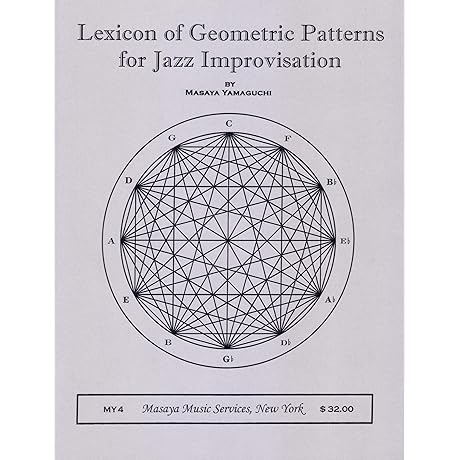
PROS
- Comprehensive collection of geometric patterns tailored for jazz improvisation
- Enhances harmonic knowledge and expands improvisational vocabulary
- Visual representation of patterns simplifies comprehension and memorization
- Versatile resource for musicians of all levels, beginners to advanced
CONS
- May require some initial effort to grasp theoretical concepts
- Digital format may not be suitable for all musicians who prefer physical books
The Lexicon of Geometric Patterns for Jazz Improvisation is an invaluable resource for jazz musicians seeking to enrich their harmonic understanding and improvisational skills. This comprehensive guide presents a meticulously organized collection of geometric patterns that serve as a roadmap for navigating complex harmonic structures. By visually representing these patterns, the book provides an accessible and intuitive approach to learning advanced jazz harmony. Whether you're a seasoned improviser or just starting to explore the world of jazz, this lexicon will elevate your musicality to new heights.
One of the key strengths of this lexicon lies in its versatility. It caters to musicians of all levels, from beginners who are eager to expand their harmonic vocabulary to experienced players looking to refine their improvisational techniques. The clear and concise explanations make it easy to grasp even the most complex concepts. Additionally, the digital format allows for convenient access and flexibility, enabling musicians to practice and study on the go.
In this comprehensive guide, we delve into various aspects of patterns for jazz, providing a thorough understanding of their application in improvisation and composition. Understand the theoretical foundation of jazz patterns, master the art of applying them in practice, and gain valuable insights into the techniques used by renowned jazz musicians. Whether you're an aspiring jazz artist or an experienced performer, this guide will empower you to incorporate patterns into your own musical creations and elevate your jazz performance to new heights.
Frequently Asked Questions
What are the benefits of using patterns in jazz?
Incorporating patterns into jazz improvisation and composition offers numerous advantages. Patterns provide a framework for generating musical ideas, enhancing the coherence and flow of your演奏. They can also serve as a source of inspiration, stimulating your creativity and expanding your musical vocabulary.
How can I apply patterns to my jazz improvisation?
To effectively apply patterns to your jazz improvisation, start by practicing them in isolation. Familiarize yourself with the different types of patterns and their characteristic rhythms, intervals, and melodic contours. Gradually incorporate them into your improvisations, experimenting with variations and combinations to create unique and expressive solos.
Are there any specific patterns that are particularly effective in jazz composition?
While the choice of patterns depends on your personal style and the context of the composition, certain patterns have gained prominence in jazz. These include ii-V-I progressions, turnarounds, and rhythmic patterns derived from swing, bebop, and other jazz subgenres.
How can I develop my own unique patterns for jazz?
Creating your own patterns for jazz requires a deep understanding of jazz theory and a creative approach. Analyze the patterns used by your favorite jazz musicians and experiment with different combinations and variations. Draw inspiration from other genres and musical traditions to incorporate fresh and innovative ideas into your patterns.
What are the common pitfalls to avoid when using patterns in jazz?
To avoid common pitfalls when using patterns in jazz, ensure that they serve as a complement to your musical expression rather than a rigid framework. Overreliance on patterns can hinder your spontaneity and creativity. Additionally, be mindful of the context in which you employ patterns, ensuring they fit the overall mood and progression of the music.
